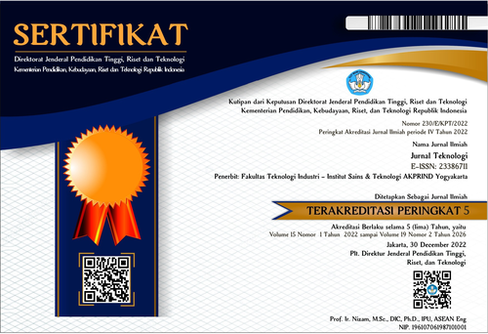STUDI ADSORPSI KARBON AKTIF LIMBAH KULIT BUAH NANGKA TERHADAP RHODAMIN B
Keywords:
karbon aktif, kulit nangka, Rhodamin BAbstract
Penelitian ini bertujuan membuat karbon aktif dari limbah buah nangka kering melalui proses pirolisis dilanjutkan dengan aktivasi kimia menggunakan garam ZnCl2 yang konsentrasinya divariasi dari 0, 0,5; 1,0; 1,5 dan 2,0 M. Karbon aktif yang dihasilkan diuji kadar air dan kapasitas serapannya terhadap I2 dengan metoda titrasi iodimetri.
Pengujian pengaruh konsentrasi garam ZnCl2 terhadap kapasitas adsorpsi karbon aktif pada Rhodamin B, dilakukan dengan menginteraksikan 100 mg karbon aktif (yang konsentrasi aktivatornya bervariasi dari 0, 0,5; 1,0; 1,5 dan 2,0 M) dengan 25 mL larutan Rhodamin B pada konsentrasi tetap. Rhodamin B yang tidak teradsorp ditentukan dengan spektrofotometer UV-Vis. Karbon yang paling teraktifkan kemudian diuji kapasitas adsorpsinya terhadap Rhodamin B dengan menginteraksikan 100 mg karbon aktif dengan 25 mL larutan Rhodamin B yang konsentrasinya bervariasi dari 0; 0,5; 1,0; 1,5; 2,0; 2,5 dan 3,0 ppm dengan waktu interaksi 1 jam.
Hasil penelitian menunjukkan bahwa kapasitas adsorpsi karbon aktif yang dihasilkan terhadap I2 berkisar antara 584,2- 844,6 mg/g arang aktif. Sampai dengan konsentrasi Rhodamin B sebesar 3 ppm, kapasitas adsorpsi arang aktif kulit nangka terus bertambah secara linier dan belum menunjukkan nilai maksimum. Pada konsentrasi Rhodamin B sebesar 0,5 – 3,0 ppm diperoleh kapasitas adsorpsi terbesar pada karbon aktif sebesar 14,20 mg/g. Teramati juga bahwa kenaikan konsentrasi aktivator ZnCl2 maupun konsentrasi larutan Rhodamin B tidak menaikkan kapasitas adsorpsi secara signifikan.
Downloads
References
Auta, M., 2012, Fixed Bed Adsorption Studies Of Rhodamine B Dye Using Oil Palm Empty Fruits Bunch Activated Carbon, Journal of Engineering Research and Studies E-ISSN0976-7916
Bansal, R.C. and Goyal, M., 2005, Adsorption on Activated Carbon, CRC Press Taylor & Francis Group 6000 Broken Sound Parkway NW, Suite 300 Boca Raton,
Chang, C.F., Chang C.Y. and Tsai, W.T., 2000, Effects of Burn-of and Activation Temperature on Preparation of Activated Carbon from Corn Cob Agrowaste by CO2 and Steam, Journal of Colloid and Interface Science 232, 45–49 (
Foo, K.Y. and Hameed B.H., 2012, Potential of Jackfruit Peel as Precursor for Activated Carbon Prepared by Microwave Induced NaOH Activation. Journal of Bioresource Technology vol 112 pp 143-150.
De Silva F, 2000, Activated Carbon Filtration, Published in Water Quality Products Magazine, January
Hernandez J.R., Capareda S. C. dan Aquino F.L., 2007, Activated Carbon Production from Pyrolysis and Steam Activation of Cotton Gin Trash , Beltwide Cotton Conferences, New Orleans, Louisiana, January 9-12.
http://www.bps.go.id, Produksi Buah-buahan Indonesia Tahun 2007-2011, diakses tanggal 20 Februari 2013
Pradhan, S., 2011, Production and Characterization of Activated Carbon Produced from a Suitable Industrial Sludge, A Report Submitted in Partial Fulfillment of The Requirements for The Degree of Bachelor of Technology (Chemical Engineering), Department of Chemical Engineering National Institute of Technology Rourkela
Prahas, D., Kartika. Y., Indraswati, N. and Ismadji, S., 2008, Activated Carbon From Jackfruit Peel Waste By H3PO4 Chemical Activation: Pore Structure And Surface Chemistry Characterization, Chemical Engineering Journal, vol 140, issues 1-3, pp 32-42
Ramli, R.A., 2009, Physicochemical Characteristics of Calcium-Treated Jackfruit (Artocarpus Heterophyllus) Pulps During Chilled Storage, Thesis submitted in fulfillment of the requirements for the Degree of Doctor of Philosophy UKM
Sivaraj, R., Rajendran, V. and Gunalan G.S., 2010, Preparation and Characterization of Activated Carbons from Parthenium Biomass by Physical and Chemical Activation Techniques, E-Journal of Chemistry, 7(4), 1314-1319
Srinivasakannan,C., 2003, High Surface Area Activated Carbon from Waste Biomass, Proceedings of the 2nd Regional Conference on Energy Technology Towards a Clean Environment 12-14 February, Phuket, Thailand
Wiche, 1992, Mempelajari cara pembuatan cide nangka (Artocarpus Heterophyllus), Skripsi Jurusan Teknologi Pangan dan Gizi, Fakultas Teknologi Pertanian, IPB
Downloads
Published
How to Cite
Issue
Section
License
Jurnal Teknologi provides immediate open access to its content in order of making research freely available to the public to support a global exchange of knowledge. All articles published in this journal are free for everyone to read and download, under licence CC BY SA.
Benefits of open access for the author, include:
- Free access for all users worldwide.
- Authors retain copyright to their work.
- Increased visibility and readership.
- No spatial constraints.




















